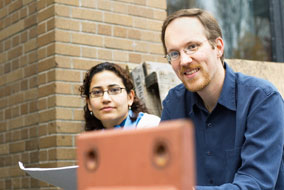
Civil Engineering masters student Sahar Safaie and Asst. Prof. Ken Elwood - photo by Martin Dee UBC Reports | Vol. 52 | No. 1 | Jan. 9, 2006
Engineering Students Compile Seismic Guidelines for Tsunami Reconstruction
By Brian Lin
Sahar Safaie prepared herself for the worst natural disaster in recent history when she traveled to northern Sumatra in July to observe and document the reconstruction process in the tsunami-ravaged region.
What she found -- through witnessing the resilience of people who had lost so much, and yet remained hopeful of the future -- was the motivation to apply her knowledge and the determination to make a difference in the world.
“I was very excited about being on the ground and I was hoping to be able to do something about the devastation,” says Safaie, a master’s student in the Dept. of Civil Engineering. “But when I finally got there and saw the overwhelming destruction, I felt utterly powerless, I thought, how could a graduate student like me be any help to these people?”
Safaie’s faculty advisor, Civil Engineering Asst. Prof. Ken Elwood, joined her and five other engineering students -- Michella Wiriahardja, Rishi Gupta, Shabnam Hosseini, Chris Meisl and Reza Kowsari -- on the reconnaissance trip. He says witnessing the damage after a disaster can be extremely difficult for a young researcher.
“My first post-disaster field project was Turkey in August 1999 after the Koceali earthquake and I went through the same experience,” says Elwood.
“It is natural to feel frustrated and hopeless when faced with all the devastation. But once you realize that, as earthquake engineers, through our research and teaching, we can provide the tools to reduce the losses in the future. This type of experience provides the motivation to do research of tremendous significance.”
When Safaie discovered there were no specific guidelines that accounted for seismic risks, she saw an opportunity to do something that could have long-term ramifications for the safety of people in the region.
“The available guideline which was developed for the reconstruction process was not providing adequate information for construction practice and seismic performance of buildings,” says Safaie.
The team, which included graduate students in structural, materials, mechanical and earthquake engineering, as well as a UBC undergraduate student originally from Indonesia, came up with a plan to remedy the situation.
They began developing a reference document for Confined Masonry Construction method, which is the most common construction practice in Indonesia before and after tsunami. This type of construction is also practiced in South America, the Middle East, Eastern Europe, and South East Asia. Safaie has since completed a review of existing research on confined masonry buildings and a team of graduate students are collecting guidelines from other countries and highlighting contradictions in published guidelines, a project that will continue through the next school term. They are planning to make this reference document available to organizations dealing with reconstruction both in Indonesia and in Pakistan.
Since the team returned to Vancouver, they have presented their findings to raise awareness here in Canada while continuing to provide support to Indonesian NGOs and reconstruction teams.
“The trip to Aceh was an invaluable experience for everyone on the team. We learned a great deal about disaster relief work and international development,” says Safaie. “It proved that young students have a lot to contribute if they believe in something and work hard to achieve it. Personally, this trip was the highlight of my Master’s education, and it helped me realize where my passion lies -- international development -- and what I’m good at -- leadership,” says Safaie, who adds that the trip would not have been possible without the support of Elwood, the UBC Go Global Student Exchange program and the Interdisciplinary Working Group, headed by political science PhD student Shane Barter (see Tsunami Response One Year Later).
Elwood who remains a technical advisor with Build Change, a local NGO working on reconstruction in Indonesia, has arranged for reference books donated by UBC faculty to be delivered to reconstruction teams in the area.
Shortly after the October 2005 earthquake in Pakistan, the team was asked to provide reconstruction resources. “It’s rewarding to see a focus on improved reconstruction practices occurring now in other regions,” says Elwood.
For additional information on UBC's response to the tsunami disaster and ways you can help, please visit www.ubc.ca/tsunami. |
